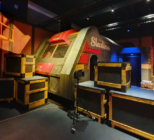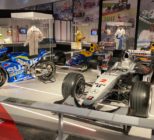In November, Elmwood Projects handed over a significant and exciting project which began pre-Covid back in early March – a full exhibition refurbishment and fit out project for the Argyll & Sutherland Highlanders Regimental Museum at Stirling Castle.
Part of a two-year, £4 million redevelopment of the Museum, the new exhibition fit out took place inside the King’s Old Buildings within the Castle, enhancing its current offering and providing a unique new opportunity for visitors to explore the beautiful buildings and gain an understanding of their history and significance.
Elmwood’s completed exhibition comprised the full project management – manufacture and installation of setworks and plinths, installation of graphic frames and the management of a supply chain carrying out the specialist packages in showcases, graphics and interactives.
AV Hardware items, including screens, were seamlessly integrated into the setworks pre-delivery, and a range of interactives and showcases – both stand alone and integrated – were also successfully installed on-site.
The fit out experienced a hiatus between late March and mid-July due to the Covid-19 lockdown, however the Exhibition Fit Out specialist’s proactive team were able to store and stockpile all their necessary equipment and materials at the Regiment’s facility in Forthside – ready to restart work as soon as it was possible.
Once the Elmwood team was able to get back on site, they were among the first fit out contractors in the sector to establish and implement new Covid Operating Procedures – on site, in their factory and at their HQ offices – after the first lockdown.
Developing an already extensive experience within scheduled monuments, historic buildings and live environments, Elmwood worked closely with Historic Environment Scotland, alongside exhibition designer PLB and Base Build contractor Taylor & Fraser, on this exciting exhibition.

The particular complexities and implications of the project, and the close involvement of Historic Environment Scotland, meant daily meetings and approval from the body were necessary before any work was undertaken.
Given that the Castle is a scheduled monument, no fixing to any historic stone was permitted unless into mortar joints or modern linings. Thus, the Design, Production and Site teams at Elmwood worked together to call on their resourcefulness and innovative skills by designing and manufacturing setworks to be stand alone when built with the weight transferred to both the modern flooring and ceiling.
The Museum’s centuries-old structure, location and position also presented the team with a range of logistical challenges. The access route for all deliveries to the exhibition fit out passed via the Castle Esplanade, over a drawbridge and through a narrow archway to the Guard House Square; all surrounded by historic stonework which needed diligent protection. This naturally meant some significant size and weight restrictions applied to all vehicles and deliveries.
Furthermore, the building was also occupied by museum staff and visitors throughout the project works and it was ensured that their health & safety was the priority at all times, with clear signage in place and suitable hoarding separating them from the working areas. Also, given the implementation of Covid operating procedures, extra signage for awareness and area demarcation, hand sanitising stations and temperature checking areas were all installed and rigidly adhered to.

As well as documenting the history of the Argylls, the Museum also explores Scotland’s social history – sport, music and family life – and wider context of the Highland Clearances, shipbuilding and industrialisation.
Specific exhibits cover the evolution of the Regiment’s distinctive uniform, the importance of music and sport in boosting morale, the different Regiments of Argylls in Canada and Australia and the Regiment’s past roles in both conflicts and emergency relief throughout the world over many centuries. Royal connections are also explored, and the supporting roles of wider military families, plus a descriptive experience of a day in the life of a “Jock”, or Argyll soldier, in the early 20th century.
Elmwood says it has been honoured to be entrusted with this project and to deliver a visitor experience of international quality, telling the inspirational stories of the Argyll & Sutherland Highlanders, their heritage and history. Improvements to access and space have also been made as well as an engaging new presentation of the Museum’s collections.
Funding for the refurbishment was provided by the Heritage Lottery Fund, Historic Environment Scotland and other donors. One additional room – the Douglas Room – will be completed by the year end and the Museum hopes to open its doors to visitors from March 2021 complete with fascinating, freshly installed exhibits.










